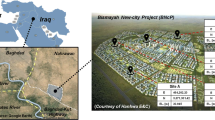Abstract
It is important to do monitoring of works during construction of Civil Engineering Projects due to many aspects including for safety purposes and information on the performance of the on going activities. Many engineers have done so, however they have used them only as data reporting without providing any interpretation and understanding, hence the reports are meaningless; no further use on the collected data except when failures occur and it is too late to provide necessary action. In many cases, these data provide feedback for design and analysis assumption where designers may assess the performance of his own design, giving a chance to review and revise the dimensions or even to save when overdesigning or to strengthen if the design is critical. Based on these data, back analysis can be conducted to confirm the design. The geotechnical instrumentations have been used to measure pore water pressures (piezometers), surface settlement (settlement plate), subsurface settlement (extensometers), subsurface horizontal movement (inclinometers), inclinations of structures (tiltmeters), soil pressures (stress cell) etc. This paper represents experience of the authors’ works throughout many years of geotechnical projects on the use of the geotechnical instrumentation such as the case of slope failures and landslides, excavation, heave and excess pore pressures due to pile driving, bridge monitoring in landslides area, reclamation works etc. The first case history is on failures of sheetpiles on Soft Soils and the second case is on the damage of buildings due to mass driven piling works. Many lessons learned from these observations using instrumentation and many data were obtained to prove the assumptions or new findings enhancing the theory, but most important is the generated excess pore pressure monitored by the geotechnical instrumentations may reveal the cause of failures and most important role of geotechnical instrumentation to serve for the public safety.
Access this chapter
Tax calculation will be finalised at checkout
Purchases are for personal use only
Similar content being viewed by others
References
Airhart, T.P., Coyle, H.M., Hirsch, T.J., Buchanaan, S.J.: Pile-soil response in a cohesive soil. In: ASTM, STP, vol. 444, pp 264–294 (1969)
Bjerrum, L., Johannessen I.J.: Pore pressures resulting from driving piles in soft clays. In: Proceeding of the Conference on Pore Pressures and Suction in Soils, Butterworth, Sydney, Australia, pp. 14–17 (1960)
Bozozuk, M., Fellenius, B.H, Samson, L.: Soil disturbance from pile driving in sensitive clay. Can. Geotech. J. 15, 346–361 (1978)
Dunnicliff, J.: Geotechnical Instrumentation. Willey (1993)
Fellenius, B.H., Harris, D.E., Anderson, D.G.: Static loading test on a 45 m long pipe pile in Sand Point, Idaho. Can. Geotech. J. 41, 613–628 (2003)
Fleming, K., Weltman, A.M., Elson, K.: Piling Engineering, 3rd edn. Taylor and Francis (1985)
Lo, K.Y., Stermac, A.G.: Induced pore pressures during pile driving operations. In: Proceeding of the International Conference of Soil Mechanics and Foundation Engineering, vol. 2 (1965)
Poulos, H.G., Davis, E.H.: Pile Foundation Analysis and Design. Wiley (1980)
Rahardjo, P.P, Widianggoro, B., Yakin, Y.A., Darmawan, H.: Determination of the degree of consolidation of Reclaimed Site on deep soft Mahakam deltaic soils using CPTu. In: Proceeding of the 4th International Symposium on Deformation Characteristics of Geomaterial, Atlanta, USA (2008)
Rahardjo, P.P., Wirawan, A., Setiawa, R.: Analytical and empirical study on ground movement and excess pore pressures generation due to massive pile driving in soft soils. In: Proceeding of the International Conference on State of The Art of Pile Foundation Technology PILE2013, Bandung Indonesia (2013)
Rahardjo, P.P.: CPTu in consolidating soils. In: Proceeding International Conference on Site Characterization (ISC-5), ISSMGE, Goldcoast, Australia (2016)
Author information
Authors and Affiliations
Corresponding author
Editor information
Editors and Affiliations
Rights and permissions
Copyright information
© 2021 The Author(s), under exclusive license to Springer Nature Singapore Pte Ltd.
About this paper
Cite this paper
Rahardjo, P.P., Anggoro, B.W. (2021). The Use of Geotechnical Instrumentation and CPTu for Investigation of Geotechnical Failures During Construction in Civil Engineering Projects. In: Mohammed, B.S., Shafiq, N., Rahman M. Kutty, S., Mohamad, H., Balogun, AL. (eds) ICCOEE2020. ICCOEE 2021. Lecture Notes in Civil Engineering, vol 132. Springer, Singapore. https://doi.org/10.1007/978-981-33-6311-3_124
Download citation
DOI: https://doi.org/10.1007/978-981-33-6311-3_124
Published:
Publisher Name: Springer, Singapore
Print ISBN: 978-981-33-6310-6
Online ISBN: 978-981-33-6311-3
eBook Packages: EngineeringEngineering (R0)




